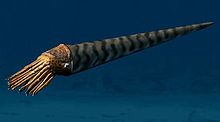- Orthoceratidae
-
Orthoceratidae
Temporal range: Ordovician - Permian (possibly Triassic)
Orthoceras Scientific classification Kingdom: Animalia Phylum: Mollusca Class: Cephalopoda Subclass: Nautiloidea Order: Orthocerida Family: Orthoceratidae
McCoy, 1844genera Kionoceras
Michelinoceras
Orthoceras
Trilacinoceras
and many othersSynonyms Orthocerotidae
Orthoceratidae, is an extinct family of actively mobile carnivorous cephalapods, subclass Nautiloidea, that lived in what would be North America, Europe, Asia, Africa, and Australia from the Ordovician through Triassic from 490—203.7 mya, existing for approximately 286.4 million years.[1]
Taxonomy
Orthoceratidae was named by McCoy (1844) and assigned to the Orthocerida by Teichert and Miller (1939),(as Orthocerotidae);[2] to the Michelinoceratida by Flower (1962),[3] and to the Orthocerataceae by Sweet (1964).[2] It has been subsequently included in the Orthocerataceae in Evans (1994) and in the Orthocerida in Evans (2005) [4] and in Kröger et al. (2007)[5] Flower showed in 1962[3] that Orthocerotidae used by Teichert and Miller (1939) is synonymous with Orthoceratide McCoy (1884)
Morphology
Members are characterised by long, slender, usually orthoconic (straight) but sometimes slightly-curved shells, a central or subcentral orthochoanitic siphuncle that is free of deposits, a long body chamber, and cylindrical or only slightly-inflated connecting rings. Ornamentation may be in the form of longitudinal or transverse ribs and/or lirae, or the shell surface may be smooth.
References
- ^ PaleoBiology Database: Orthoceratidae, basic info
- ^ a b Sweet, Walter C., (1964), Nautiloidea --Orthocerida, in Treatise on Invertebrate Paleontology. Part K. Mollusca 3. pp K224-K231.
- ^ a b R. H. Flower. 1962. Memoir 10, Part 2; Notes on the Michelinoceratida. New Mexico Bureau of Mines and Mineral Resources, Socorro NM.
- ^ D. H. Evans. 2005. The Lower and Middle Ordovician cephalopod faunas of England and Wales. Monograph of the Palaeontographical Society 623:1-81
- ^ B. Kröger, M. S. Beresi, and E. Landing. 2007. Early orthoceratoid cephalopods from the Argentine Precordillera (Lower-Middle Ordovician). Journal of Paleontology 81(6):1266-1283
- Dzik, Jerzy (1984) Phylogeny of the Nautiloidea, Palaeontologica Polonica, no. 43
Notable fossil cephalopods (listed by first occurrence) Cenozoic The belemnite-cuttlefish-like Belosaepia
Evolutionary history of cephalopodsMesozoic - Advanced nautiloids: Nautilaceae • True ammonites
- Early coleoids: Proteroctopus, Styletoctopus, Keuppia, Palaeoctopus, Paleocirroteuthis
- Ceratitid ammonoids • late Nautilida
- Advanced belemnoids: Diplobelids: Diplobelus • Belemnites: Belemnites, Belemnopsis, Belemnotheutis
Palaeozoic - First appearance of long-lasting lineages: Goniatite and ceratite ammonoids • Probable coleoid ancestor Bactritida • Earliest belemnoids: Aulacocerids: Aulacoceras • Phragmoteuthids: Phragmoteuthis
- Early forms: the earliest cephalopod group Ellesmerocerida • Orthocones: Endocerida, Orthocerida, Actinocerida • Brevicones: Ascocerida, Oncocerida • Earliest coiled cephalopods: Tarphycerida • Spirulid?: Shimanskya
- Octopus: Pohlsepia
Cambrian - Earliest unambiguous cephalopods: Plectronocerida (Plectronoceras)
- Monoplacophoran-like ancestral forms: Knightoconus
- Possible, nude, "stem-group cephalopods": Nectocarididae
Categories:- Extinct cephalopods
- Nautiloids
Wikimedia Foundation. 2010.
